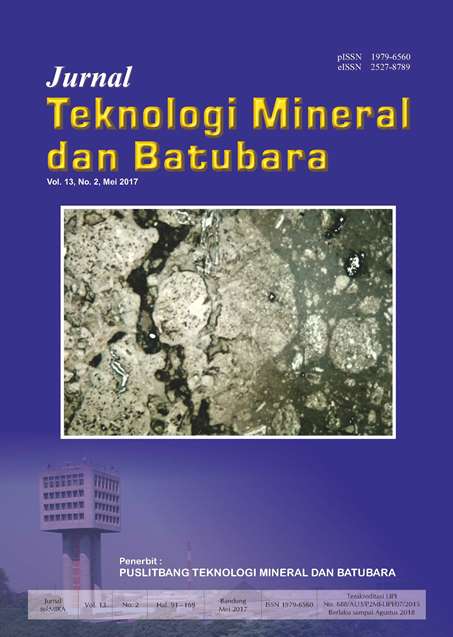EKSTRAKSI EMAS DARI LUMPUR ANODA MELALUI PROSES KLORINASI BASAH DAN EKSTRAKSI PELARUT
DOI:
https://doi.org/10.30556/jtmb.Vol13.No2.2017.170Kata Kunci:
lumpur anoda, emas, klorinasi, ekstraksi pelarut, dibutyl carbitolAbstrak
Percobaan mengekstraksi emas dilakukan secara selektif dari residu pelindian timbal dalam lumpur anoda melalui proses klorinasi basah, diikuti proses ekstraksi pelarut menggunakan ekstraktan pelarut organik dibutyl carbitol (DBC). Hasilnya menunjukkan bahwa pemberaian emas oleh pelindi HCl atau gas Cl2 yang dibantu oksidator H2O2 ternyata sangat efektif, bahkan menjadi lebih efektif jika menggunakan peralatan pelindian yang kedap gas. Berikutnya, proses ekstraksi pelarut terhadap larutan mengandung emas hasil klorinasi menunjukkan terbentuknya larutan organo-emas (loaded DBC) meningkat dengan meningkatnya konsentrasi DBC hingga 40% (v/v) dengan lama waktu pengadukan yang singkat, persen ekstraksi emas yang diperoleh adalah 99,31%. Akhirnya, loaded DBC direduksi untuk menghasilkan logam emas.
Referensi
Baba, A. A., Adekola, F. A., Ojutemieden, D. O. and Dada, F. K. (2011) “Solvent extraction of gold from hydrochloric acid-leached Nigerian gold ore by tributylphosphate,” 56(70)(1), pp. 29–37.
Bindi, L. and Cipriani, C. (2004) “Structural and physical properties of fischesserite, a rare gold-silver selenide from the De Lamar mine, Owyhee County, Idaho, USA,” The Canadian Mineralogist, 42, pp. 1733–1737. doi: 10.2113/gscanmin.42.6.1733.
Chen, A., Peng, Z., Hwang, J.-Y. Y., Ma, Y., Liu, X. and Chen, X. (2015) “Recovery of silver and gold from copper anode slimes,” JOM, 67(2), pp. 493–502. doi: 10.1007/s11837-014-1114-9.
Filcenco-Olteanu, A., Dobre, T., Panturu, E., Radulescu, R. and Groza, N. (2010) “Recovery of gold from alluvial sand by wet chlorination,” REV. CHIM. (Bucuresti), 61(2), pp. 223–226.
Filcenco-Olteanu, A., Dobre, T., Radulescu, R., Panturu, E. and Panturu, R. (2010) “Selective recovery of gold from hydrochloric solutions with amberlite XAD-7 ion-exchange resin,” UPB Scientific Bulletin, Series B: Chemistry and Materials Science, 72(3), pp. 233–242.
Filcenco Olteanu, A., Dobre, T., Panturu, E., Radu, A. D. and Akcil, A. (2014) “Experimental process analysis and mathematical modeling for selective gold leaching from slag through wet chlorination,” Hydrometallurgy, 144–145, pp. 170–185. doi: 10.1016/j.hydromet.2014.02.011.
Rodliyah, I., Ardha, N., Saleh, N. and Mubarok, Z. (2011) “Leaching the lead from anode slime by ammonium acetate solution,” Indonesian Mining Journal, 14(3), pp. 123–132.
Rodliyah, I., Nuryadi Saleh, Ardha, N. and Mubarok, Z. (2013) “Effect of oxidizing agents in extracting gold from anode slime,” Indonesian Mining Journal, 16(3), pp. 154–161.
Sekiguchi, S., Niikura, K., Matsuo, Y. and Ijiro, K. (2012) “Hydrophilic gold nanoparticles adaptable for hydrophobic solvents,” Langmuir, 28(13), pp. 5503–5507. doi: 10.1021/la300299x.
Wang, S. and Kim, D. (2014) “Process for the recovery of gold from anode slimes.” United State.
Unduhan
Diterbitkan
Cara Mengutip
Terbitan
Bagian
Lisensi
Jurnal Teknologi Mineral dan Batubara menyediakan akses terbuka yang pada prinsipnya membuat konten yang tersedia dapat diakses secara gratis untuk umum dan mendukung pertukaran informasi/pengetahuan secara global.

Jurnal Teknologi Mineral dan Batubara berada di bawah lisensi Creative Commons Attribution-NonCommercial 4.0 International License.
Jurnal Teknolgi Mineral dan Batubara provides immediate open access to its content on the principle that making research freely available to the public to supports a greater global exchange of knowledge.

Jurnal Teknologi Mineral dan Batubara is licensed under a Creative Commons Attribution-NonCommercial 4.0 International License.














